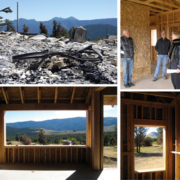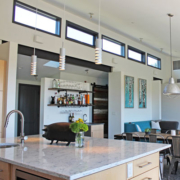The Curse of Houzz (and 5 ways to make it a blessing)
By David Barrett, Architect
Need ideas for your kitchen remodel? No problem. On Houzz.com you have access to four million colorful photos of interiors and exteriors. Simply filter on 15 different attributes including number of islands, kitchen shape, and even backsplash color.
Houzz has become a mighty mecca for savvy homeowners and home design enthusiasts looking for inspiration. The site is 25 million people strong, and growing.
From my perspective as an architect, Houzz is both a blessing and a curse.
For years design enthusiasts have been collecting ideas from coffee table books, articles from design magazines, and even snapping their own photos from all over the world of what strikes their fancy. Then they would meet with the architect, turn over their handful of clippings and excitedly say, “I want something like this!”
The trouble is, Houzz has pumped up any person’s image-gathering capacity a million-fold.
Which leads me to the curse of Houzz: dead architecture.
Houzz shows you yesterday’s singular creative designs for someone else in some other place. Even if it is unconscious, you can end up wanting this montage of Houzz images which if actually built, is a fragmented, impersonal, soul-less space that lacks connection to your site, your climate, your budget and the people living in your home.
There’s an even bigger loss with a heightened focus on image, style and consumerism: in some ways you are avoiding real creativity.
Real creativity is uncomfortable. It’s intense to step into the unknown and try to uncover some part of yourself that longs to be expressed in this world. Many times fear is the predecessor to the real moment of synthesis when you find that special convergence of nature, place, needs and poetics that is truly a reflection of who you are, and where you are. Short cutting this process may be safe, but it is shallow and is only temporary in its gratification – until the next wave of Gee Whiz images come your way.
That said, finally I come to the blessing of Houzz, and why Barrett Studio Architects is a regular contributor to the site: A picture is worth a thousand words. Communication is imperative in the design process so you want to do your due diligence in conveying who you are, what floats your boat, or what drives you absolutely mad! The whole process of idea gathering is exciting, and because the outcome of your efforts is ultimately going to manifest visually (and experientially), the natural language to express your desires is pictures.
Like most things in life it comes down to balance, and trust.
If you come to your designer with an intention to find the design of your home together, and you trust them to actually design versus assemble your Greatest Hits, then you’re headed for a co-creation-amazing-things-can-happen experience. The poetic seeds of your home have room to take hold – a home that is rooted in the soil of your life and memories – and your site will endure. Who knows, your unique living environment might just show up on Houzz!
If you’re a Houzz lover, or are feeling the gravitational pull toward Houzz, here are 5 ways to keep Houzz the blessing that it is:
- Houzz is great for getting new ideas and shaking up your viewpoint. But absolutely have an idea of what you need before going there. If you need flooring ideas, it’s a great tool to see what’s out there. If you hit Houzz with no goal, no vision, no soul searching beforehand….yikes.
- When viewing a photo, discern exactly what appeals to you. Is it the style, the color, the materials? If you saw the same photo and the countertop was blue instead of red, would it still be your favorite? Become a discerning viewer.
- Discover how the image makes you feel. Look at a clean, crisp kitchen that is white with stainless steel. Compare that to one that is warm, woodsy and cluttered. What is it that makes you feel comfortable, calm, energized, social, rested? Tell your designer the feelings that you want a room to evoke and they will love you for it!
- Rather than giving your designer multiple versions of a feature, pick the one that you like the most. One of our clients submitted three versions of built-in silverware dividers. We urged her to pick her favorite and eliminate the others.
- Know the location of the house you are viewing. When you click on a photo, Style and Location shows up on the top right of the screen. Think about the difference between the climate and culture of that house location, and your house location. Site-specific design considerations make a big difference in a house’s endurance in your life.
Happy Houzz hunting everyone!






















I agree that Houzz (as well as sites like Pinterest, Remodelista, etc.) can serve as architectural Cliff Notes or cheat sheets to short-circuit real creativity. There is also the danger that the sheer volume of material to consider conspires with our contemporary short-attention-span-syndrome so that we aren’t looking deeply into a design but simply cataloguing its surface features and specifications.
That said – and sadly, this is probably a heretical view for a real architect – sometimes real creativity is not what’s called for in, say, making a series of real estate investment-based design decisions for a spec building or a remodel. In that context the mind-numbing, blurred effect provided by the sheer volume of material on these web sites can actually serve to help circle-in towards design decisions that meet the “least common denominator” or “au courant design feature” criteria that a quick real estate sale demands. (Although it is more depressing, walking through the aisles of the big-box home improvement stores can provide a similar effect.)
After surfing through page after page of design imagery, the averages of trends, styles and fashions begin to emerge and congeal. This mass exposure can allow a designer to conclude “Yes, that’s challenging but not too much”, “Edgy, but moving mainstream” or “Oops, so last-decade!” about the market impact of a particular design decision – conclusions that it might otherwise take visiting dozens of Sunday open houses to realize.